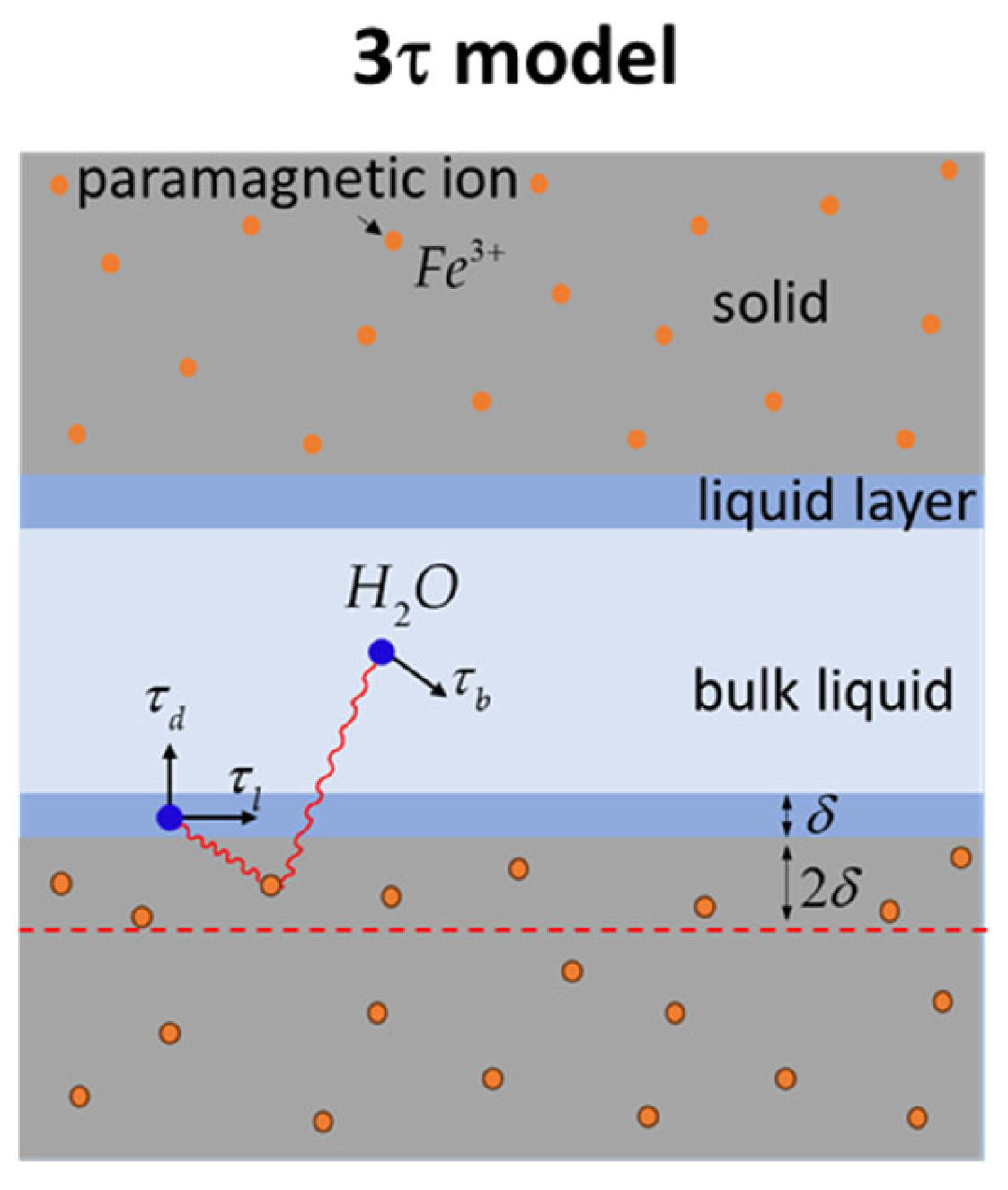Relations Between the Printability Descriptors of Mortar and NMR Relaxometry Data
Abstract
1. Introduction
2. Materials and Methods
2.1. Reagents
2.2. Extrusion Tests
2.3. Transverse Relaxation Studies at a Given Frequency
2.4. Longitudinal Relaxation Studies at Different Frequencies
3. Results and Discussions
3.1. Extrudability Tests
3.2. Probing Printable Mortars via NMR-CPMG
3.2.1. The Transverse Relaxation Time Distribution During Cement Hydration
3.2.2. Effects Introduced by SR and CN over the Hydration Kinetics
3.3. Probing the Effect of the Accelerator via NMR-FFC
3.4. NMR and Printability Descriptors
4. Conclusions
Supplementary Materials
Author Contributions
Funding
Institutional Review Board Statement
Informed Consent Statement
Data Availability Statement
Conflicts of Interest
References
- Ma, G.; Buswell, R.; Leal da Silva, W.R.; Wang, L.; Xu, J.; Jones, S.Z. Technology Readiness: A Global Snapshot of 3D Concrete Printing and the Frontiers for Development. Cem. Concr. Res. 2022, 156, 106774. [Google Scholar] [CrossRef]
- De Schutter, G.; Lesage, K.; Mechtcherine, V.; Nerella, V.N.; Habert, G.; Agusti-Juan, I. Vision of 3D Printing with Concrete—Technical, Economic and Environmental Potentials. Cem. Concr. Res. 2018, 112, 25–36. [Google Scholar] [CrossRef]
- Wangler, T.; Roussel, N.; Bos, F.P.; Salet, T.A.M.; Flatt, R.J. Digital Concrete: A Review. Cem. Concr. Res. 2019, 123, 105780. [Google Scholar] [CrossRef]
- Buswell, R.A.; Leal de Silva, W.R.; Jones, S.Z.; Dirrenberger, J. 3D Printing Using Concrete Extrusion: A Roadmap for Research. Cem. Concr. Res. 2018, 112, 37–49. [Google Scholar] [CrossRef]
- Fasihi, A.; Libre, N.A. From Pumping to Deposition: A Comprehensive Review of Test Methods for Characterizing Concrete Printability. Constr. Build. Mater. 2024, 414, 134968. [Google Scholar] [CrossRef]
- Rahman, M.; Rawat, S.; Yang, R.C.; Mahil, A.; Zhang, Y.X. A Comprehensive Review on Fresh and Rheological Properties of 3D Printable Cementitious Composites. J. Build. Eng. 2024, 91, 109719. [Google Scholar] [CrossRef]
- Marchon, D.; Kawashima, S.; Bessaies-Bey, H.; Mantellato, S.; Ng, S. Hydration and Rheology Control of Concrete for Digital Fabrication: Potential Admixtures and Cement Chemistry. Cem. Concr. Res. 2018, 112, 96–110. [Google Scholar] [CrossRef]
- Reiter, L.; Wangler, T.; Roussel, N.; Flatt, R.J. The Role of Early Age Structural Build-up in Digital Fabrication with Concrete. Cem. Concr. Res. 2018, 112, 86–95. [Google Scholar] [CrossRef]
- Roussel, N.; Lowke, D. (Eds.) Digital Fabrication with Cement-Based Materials; Springer International Publishing: Cham, Switzerland, 2022; Volume 36, ISBN 978-3-030-90534-7. [Google Scholar]
- Nagel, S.M.; Strangfeld, C.; Kruschwitz, S. Application of 1H Proton NMR Relaxometry to Building Materials—A Review. J. Magn. Reson. Open 2021, 6, 100012. [Google Scholar] [CrossRef]
- Pop, A.; Bede, A.; Dudescu, M.C.; Popa, F.; Ardelean, I. Monitoring the Influence of Aminosilane on Cement Hydration Via Low-Field NMR Relaxometry. Appl. Magn. Reson. 2016, 47, 191–199. [Google Scholar] [CrossRef]
- Rusu, M.M.; Vilau, C.; Dudescu, C.; Pascuta, P.; Popa, F.; Ardelean, I. Characterization of the Influence of an Accelerator upon the Porosity and Strength of Cement Paste by Nuclear Magnetic Resonance (NMR) Relaxometry. Anal. Lett. 2023, 56, 303–311. [Google Scholar] [CrossRef]
- Ardelean, I. The Effect of an Accelerator on Cement Paste Capillary Pores: NMR Relaxometry Investigations. Molecules 2021, 26, 5328. [Google Scholar] [CrossRef] [PubMed]
- Nicula, L.M.; Corbu, O.; Ardelean, I.; Sandu, A.V.; Iliescu, M.; Simedru, D. Freeze–Thaw Effect on Road Concrete Containing Blast Furnace Slag: NMR Relaxometry Investigations. Materials 2021, 14, 3288. [Google Scholar] [CrossRef] [PubMed]
- Rusu, M.M.; Vulpoi, A.; Vilau, C.; Dudescu, C.M.; Păşcuţă, P.; Ardelean, I. Analyzing the Effects of Calcium Nitrate over White Portland Cement: A Multi-Scale Approach. Materials 2022, 16, 371. [Google Scholar] [CrossRef]
- Bligh, M.W.; d’Eurydice, M.N.; Lloyd, R.R.; Arns, C.H.; Waite, T.D. Investigation of Early Hydration Dynamics and Microstructural Development in Ordinary Portland Cement Using 1H NMR Relaxometry and Isothermal Calorimetry. Cem. Concr. Res. 2016, 83, 131–139. [Google Scholar] [CrossRef]
- Liu, H.; Sun, Z.; Yang, J.; Ji, Y. A Novel Method for Semi-Quantitative Analysis of Hydration Degree of Cement by 1H Low-Field NMR. Cem. Concr. Res. 2021, 141, 106329. [Google Scholar] [CrossRef]
- Kurihara, R.; Maruyama, I. Surface Area Development of Portland Cement Paste during Hydration: Direct Comparison with 1H NMR Relaxometry and Water Vapor/Nitrogen Sorption. Cem. Concr. Res. 2022, 157, 106805. [Google Scholar] [CrossRef]
- Papp, V.; Janovics, R.; Péter Kertész, T.; Nemes, Z.; Fodor, T.; Bányai, I.; Kéri, M. State and Role of Water Confined in Cement and Composites Modified with Metakaolin and Additives. J. Mol. Liq. 2023, 388, 122716. [Google Scholar] [CrossRef]
- Rusu, M.M.; Faux, D.; Ardelean, I. Monitoring the Effect of Calcium Nitrate on the Induction Period of Cement Hydration via Low-Field NMR Relaxometry. Molecules 2023, 28, 476. [Google Scholar] [CrossRef]
- Simedru, A.F.; Becze, A.; Cadar, O.; Scurtu, D.A.; Simedru, D.; Ardelean, I. Structural Characterization of Several Cement-Based Materials Containing Chemical Additives with Potential Application in Additive Manufacturing. Int. J. Mol. Sci. 2023, 24, 7688. [Google Scholar] [CrossRef]
- Toma, I.-O.; Stoian, G.; Rusu, M.-M.; Ardelean, I.; Cimpoeşu, N.; Alexa-Stratulat, S.-M. Analysis of Pore Structure in Cement Pastes with Micronized Natural Zeolite. Materials 2023, 16, 4500. [Google Scholar] [CrossRef] [PubMed]
- Crețu, A.; Mattea, C.; Stapf, S.; Ardelean, I. The Effect of Silica Fume and Organosilane Addition on the Porosity of Cement Paste. Molecules 2020, 25, 1762. [Google Scholar] [CrossRef] [PubMed]
- Pop, A.; Badea, C.; Ardelean, I. The Effects of Different Superplasticizers and Water-to-Cement Ratios on the Hydration of Gray Cement Using T2-NMR. Appl. Magn. Reson. 2013, 44, 1223–1234. [Google Scholar] [CrossRef]
- Muller, A.C.A.; Scrivener, K.L.; Skibsted, J.; Gajewicz, A.M.; McDonald, P.J. Influence of Silica Fume on the Microstructure of Cement Pastes: New Insights from 1H NMR Relaxometry. Cem. Concr. Res. 2015, 74, 116–125. [Google Scholar] [CrossRef]
- Meiboom, S.; Gill, D. Modified Spin-Echo Method for Measuring Nuclear Relaxation Times. Rev. Sci. Instrum. 1958, 29, 688–691. [Google Scholar] [CrossRef]
- Kimmich, R.; Anoardo, E. Field-Cycling NMR Relaxometry. Prog. Nucl. Magn. Reson. Spectrosc. 2004, 44, 257–320. [Google Scholar] [CrossRef]
- Rahul, A.V.; Santhanam, M.; Meena, H.; Ghani, Z. 3D Printable Concrete: Mixture Design and Test Methods. Cem. Concr. Compos. 2019, 97, 13–23. [Google Scholar] [CrossRef]
- Venkataramanan, L.; Song, Y.Q.; Hurlimann, M.D. Solving Fredholm Integrals of the First Kind with Tensor Product Structure in 2 and 2.5 Dimensions. IEEE Trans. Signal Process. 2002, 50, 1017–1026. [Google Scholar] [CrossRef]
- Bede, A.; Scurtu, A.; Ardelean, I. NMR Relaxation of Molecules Confined inside the Cement Paste Pores under Partially Saturated Conditions. Cem. Concr. Res. 2016, 89, 56–62. [Google Scholar] [CrossRef]
- Faux, D.A.; McDonald, P.J. A Model for the Interpretation of Nuclear Magnetic Resonance Spin-Lattice Dispersion Measurements on Mortar, Plaster Paste, Synthetic Clay and Oil-Bearing Shale. Microporous Mesoporous Mater. 2018, 269, 39–42. [Google Scholar] [CrossRef]
- Faux, D.A.; McDonald, P.J.; Howlett, N.C. Nuclear-Magnetic-Resonance Relaxation Due to the Translational Diffusion of Fluid Confined to Quasi-Two-Dimensional Pores. Phys. Rev. E 2017, 95, 033116. [Google Scholar] [CrossRef]
- Faux, D.A.; McDonald, P.J. Explicit Calculation of Nuclear-Magnetic-Resonance Relaxation Rates in Small Pores to Elucidate Molecular-Scale Fluid Dynamics. Phys. Rev. E 2017, 95, 033117. [Google Scholar] [CrossRef]
- Faux, D.; Kogon, R.; Bortolotti, V.; McDonald, P. Advances in the Interpretation of Frequency-Dependent Nuclear Magnetic Resonance Measurements from Porous Material. Molecules 2019, 24, 3688. [Google Scholar] [CrossRef] [PubMed]
- Faux, D.A.; McDonald, P.J. Nuclear-Magnetic-Resonance Relaxation Rates for Fluid Confined to Closed, Channel, or Planar Pores. Phys. Rev. E 2018, 98, 063110. [Google Scholar] [CrossRef]
- Kogon, R.; Faux, D. 3TM: Software for the 3-Tau Model. SoftwareX 2022, 17, 100979. [Google Scholar] [CrossRef]
- Kogon, R.; Faux, D. 3TM: Fitting Software for Fast Field Cycling NMR Dispersion Data. 2021. Available online: https://zenodo.org/records/5774107 (accessed on 14 May 2022).
- Pop, A.; Ardelean, I. Monitoring the Size Evolution of Capillary Pores in Cement Paste during the Early Hydration via Diffusion in Internal Gradients. Cem. Concr. Res. 2015, 77, 76–81. [Google Scholar] [CrossRef]
- Roussel, N. Rheological Requirements for Printable Concretes. Cem. Concr. Res. 2018, 112, 76–85. [Google Scholar] [CrossRef]
- Michel, L.; Reiter, L.; Sanner, A.; Flatt, R.J.; Kammer, D.S. Structural Build-up at Rest in the Induction and Acceleration Periods of Portland Cement. Cem. Concr. Res. 2024, 186, 107665. [Google Scholar] [CrossRef]
- Jakob, C.; Jansen, D.; Ukrainczyk, N.; Koenders, E.; Pott, U.; Stephan, D.; Neubauer, J. Relating Ettringite Formation and Rheological Changes during the Initial Cement Hydration: A Comparative Study Applying XRD Analysis, Rheological Measurements and Modeling. Materials 2019, 12, 2957. [Google Scholar] [CrossRef]
- Scrivener, K.; Ouzia, A.; Juilland, P.; Kunhi Mohamed, A. Advances in Understanding Cement Hydration Mechanisms. Cem. Concr. Res. 2019, 124, 105823. [Google Scholar] [CrossRef]
- Wang, B.; Faure, P.; Thiéry, M.; Baroghel-Bouny, V. 1H NMR Relaxometry as an Indicator of Setting and Water Depletion during Cement Hydration. Cem. Concr. Res. 2013, 45, 1–14. [Google Scholar] [CrossRef]
- Jansen, D.; Neubauer, J.; Goetz-Neunhoeffer, F.; Haerzschel, R.; Hergeth, W.-D. Change in Reaction Kinetics of a Portland Cement Caused by a Superplasticizer—Calculation of Heat Flow Curves from XRD Data. Cem. Concr. Res. 2012, 42, 327–332. [Google Scholar] [CrossRef]
- Yuan, Q.; Zhou, D.; Huang, H.; Peng, J.; Yao, H. Structural Build-up, Hydration and Strength Development of Cement-Based Materials with Accelerators. Constr. Build. Mater. 2020, 259, 119775. [Google Scholar] [CrossRef]
- Dorn, T.; Hirsch, T.; Stephan, D. Working Mechanism of Calcium Nitrate as an Accelerator for Portland Cement Hydration. J. Am. Ceram. Soc. 2023, 106, 752–766. [Google Scholar] [CrossRef]
- Jiao, D.; De Schryver, R.; Shi, C.; De Schutter, G. Thixotropic Structural Build-up of Cement-Based Materials: A State-of-the-Art Review. Cem. Concr. Compos. 2021, 122, 104152. [Google Scholar] [CrossRef]
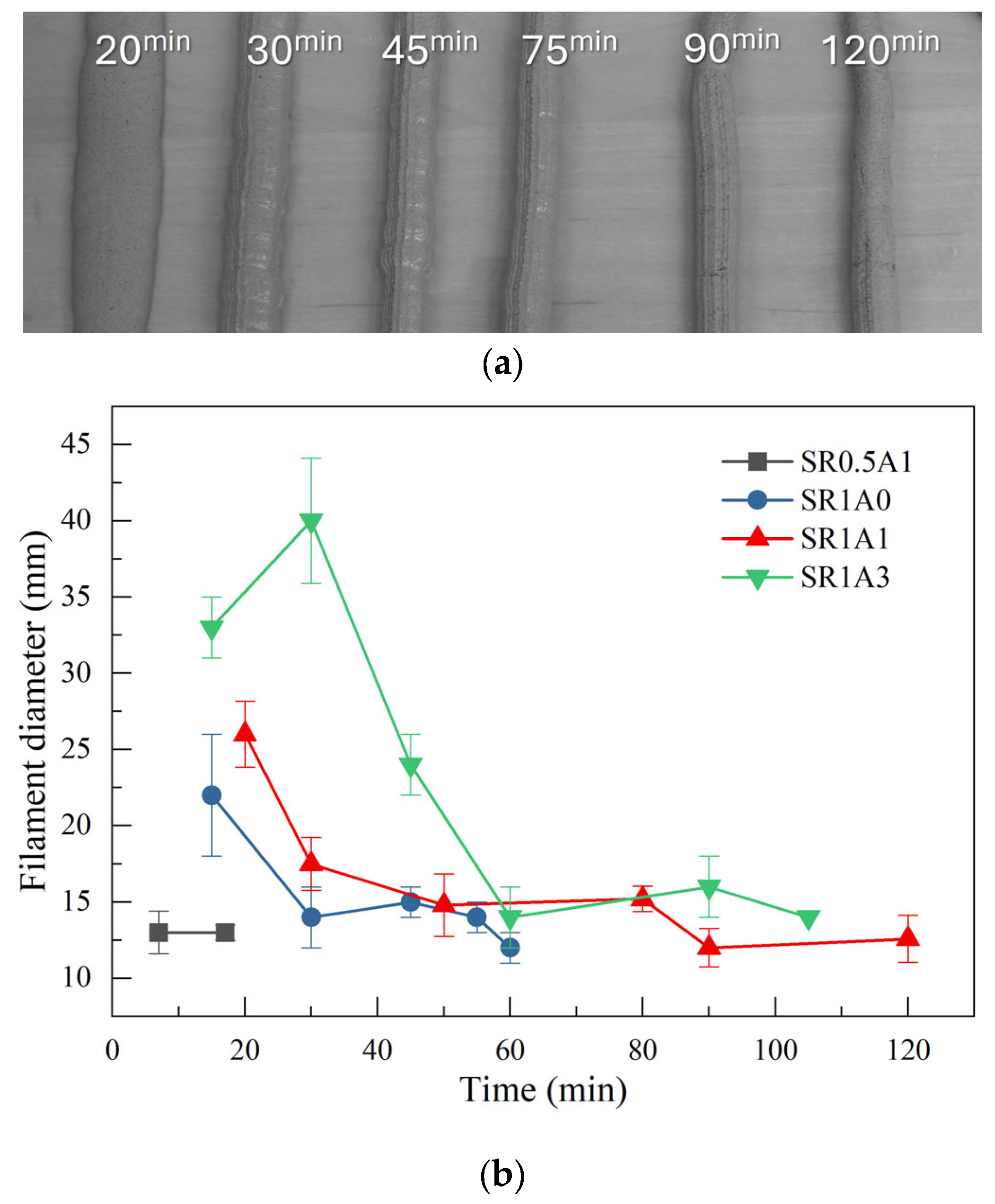
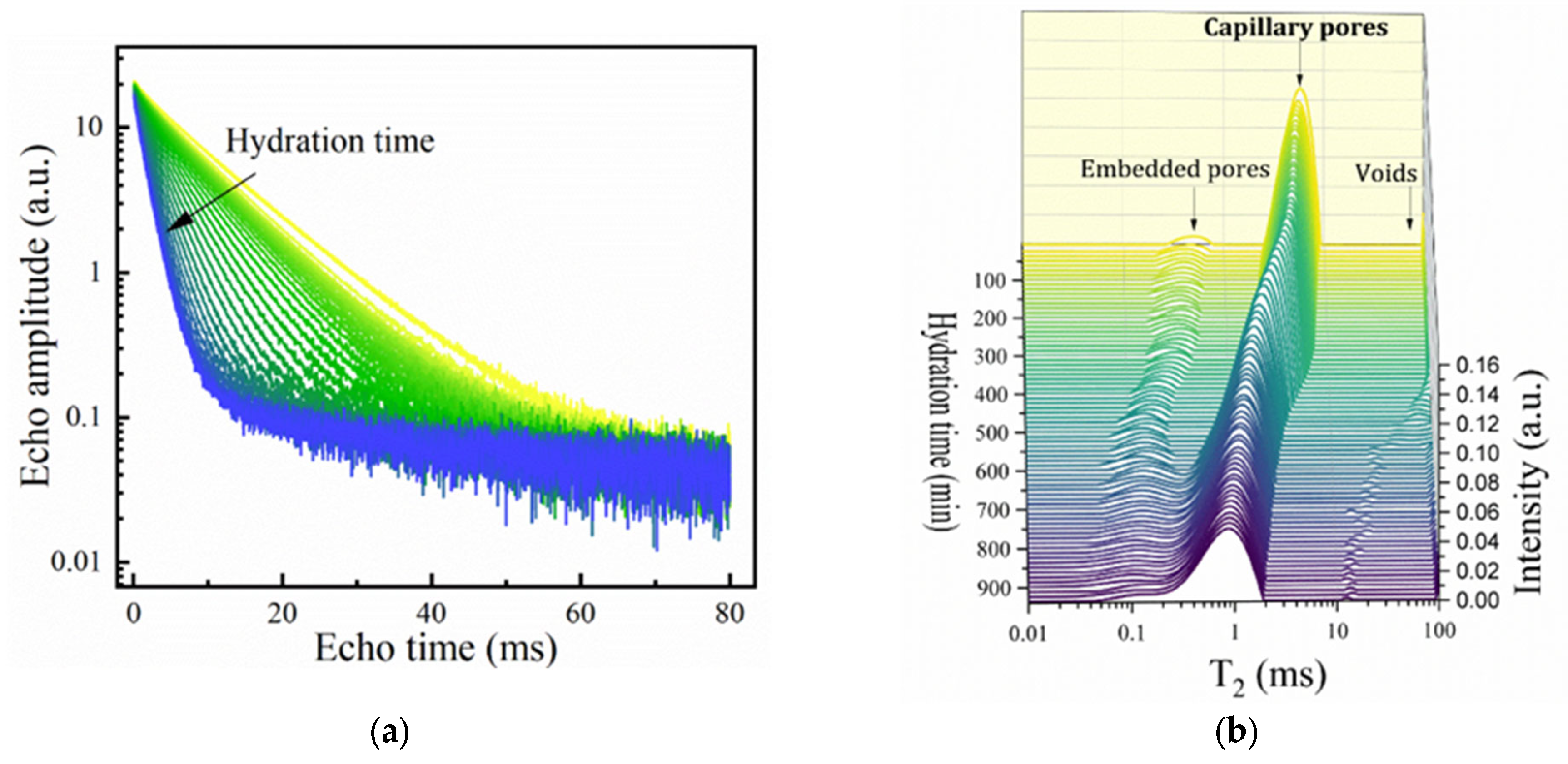
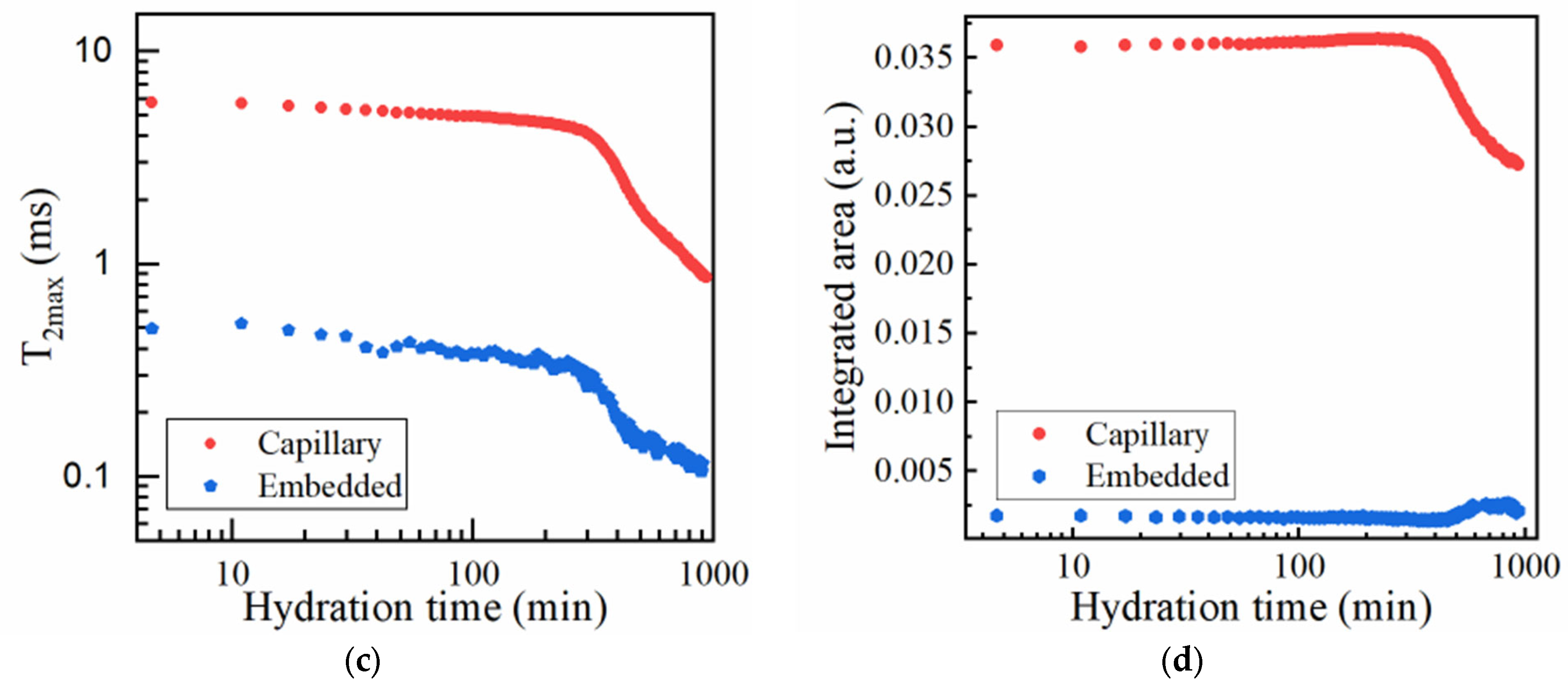
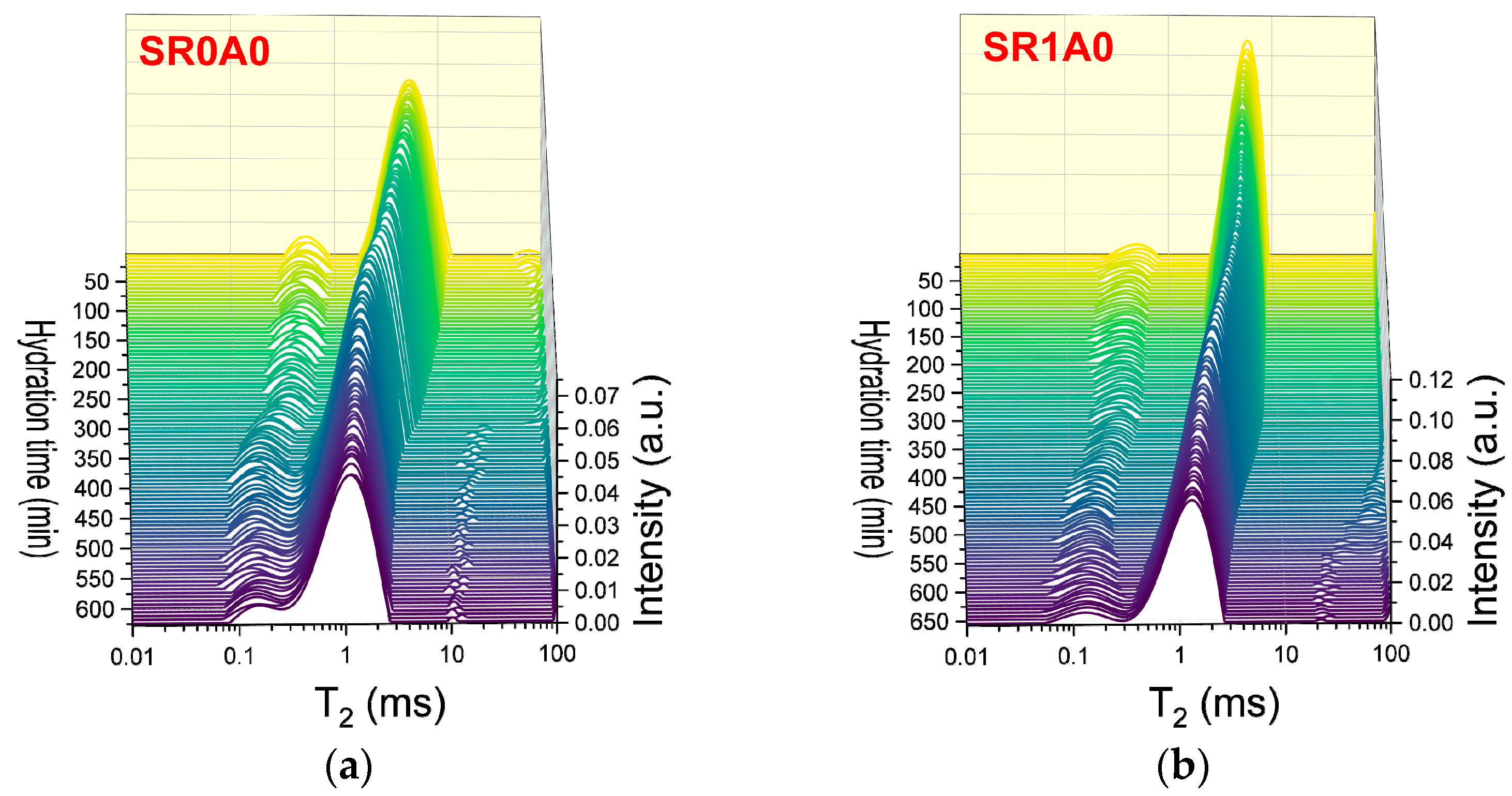

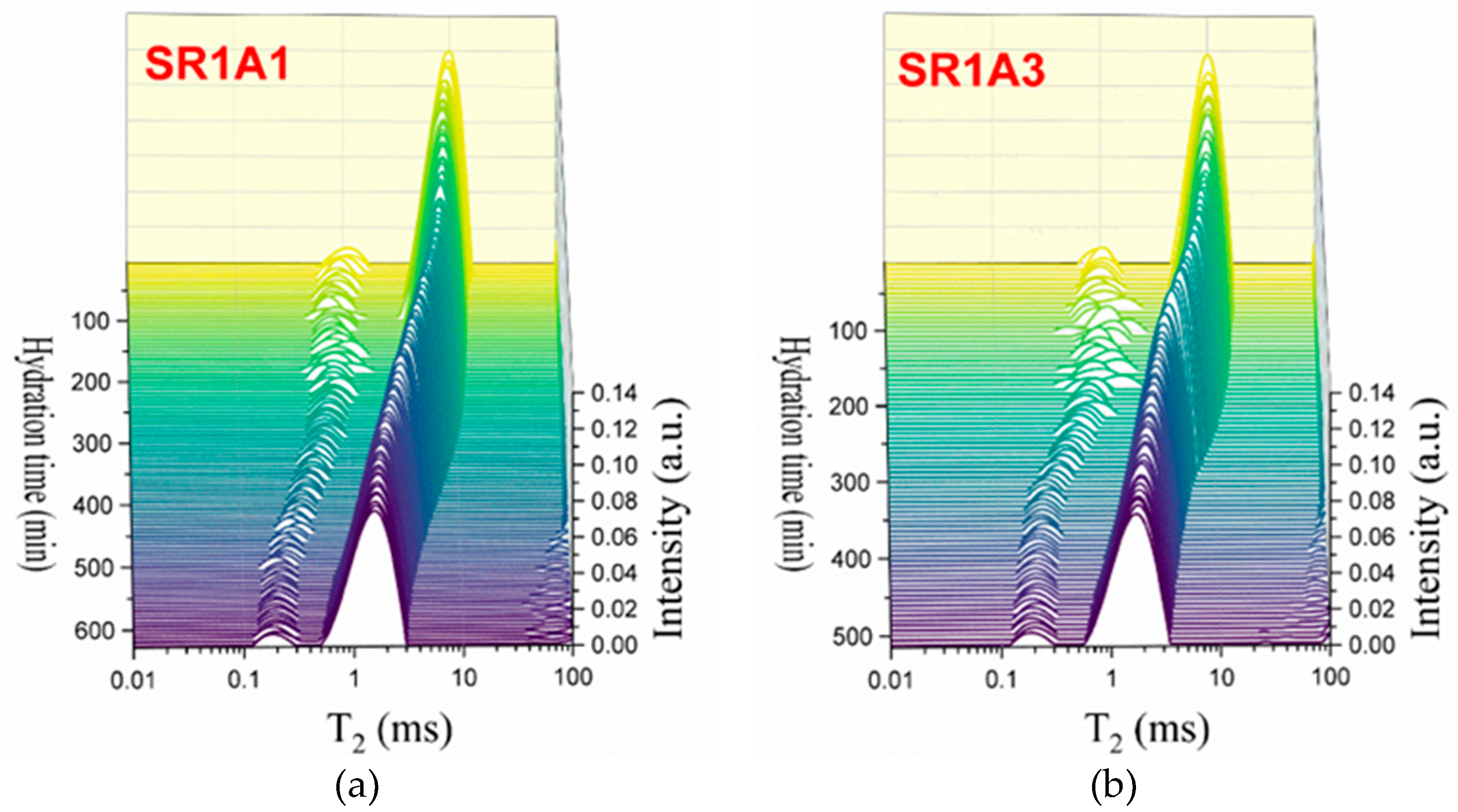
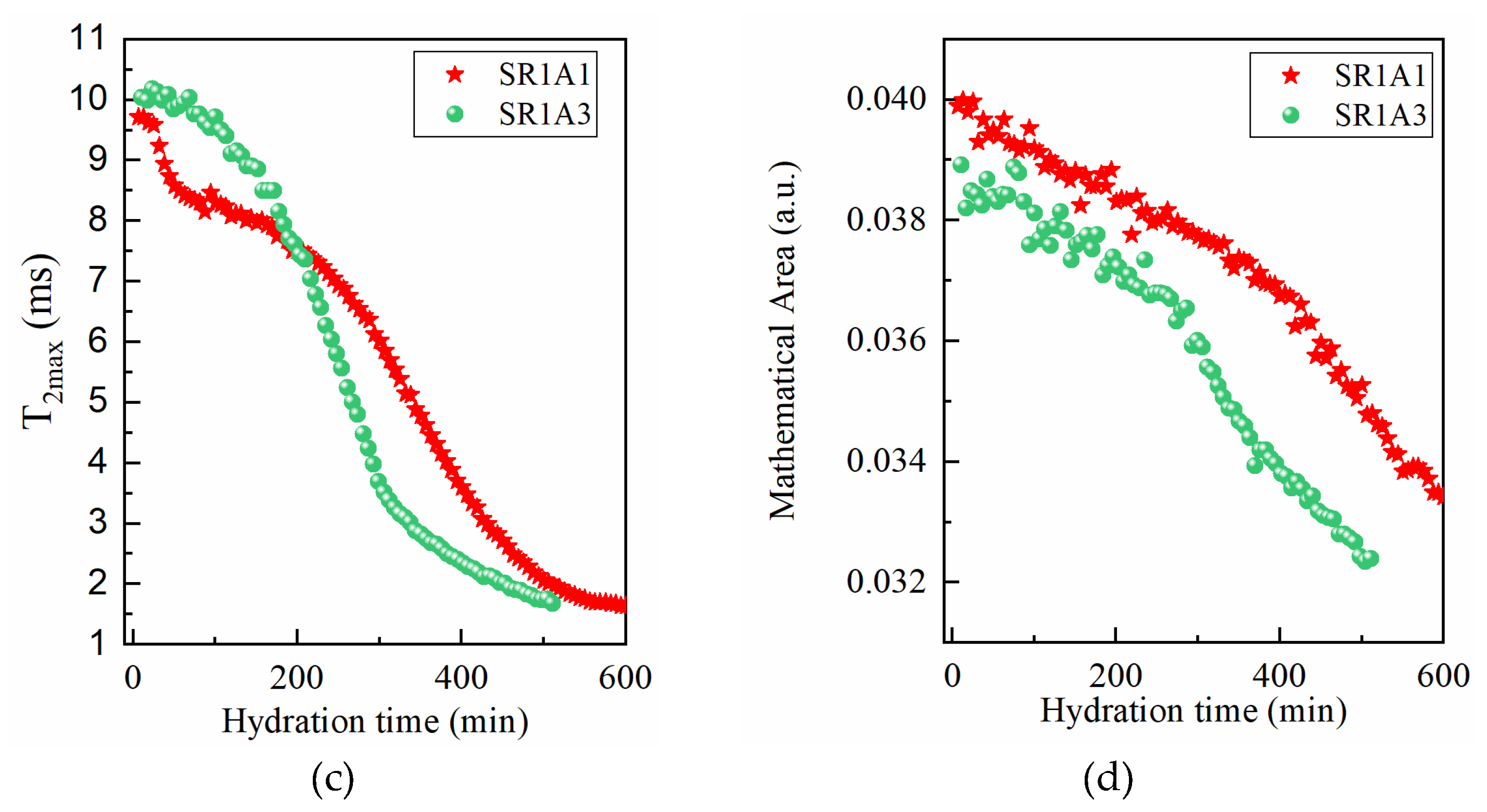

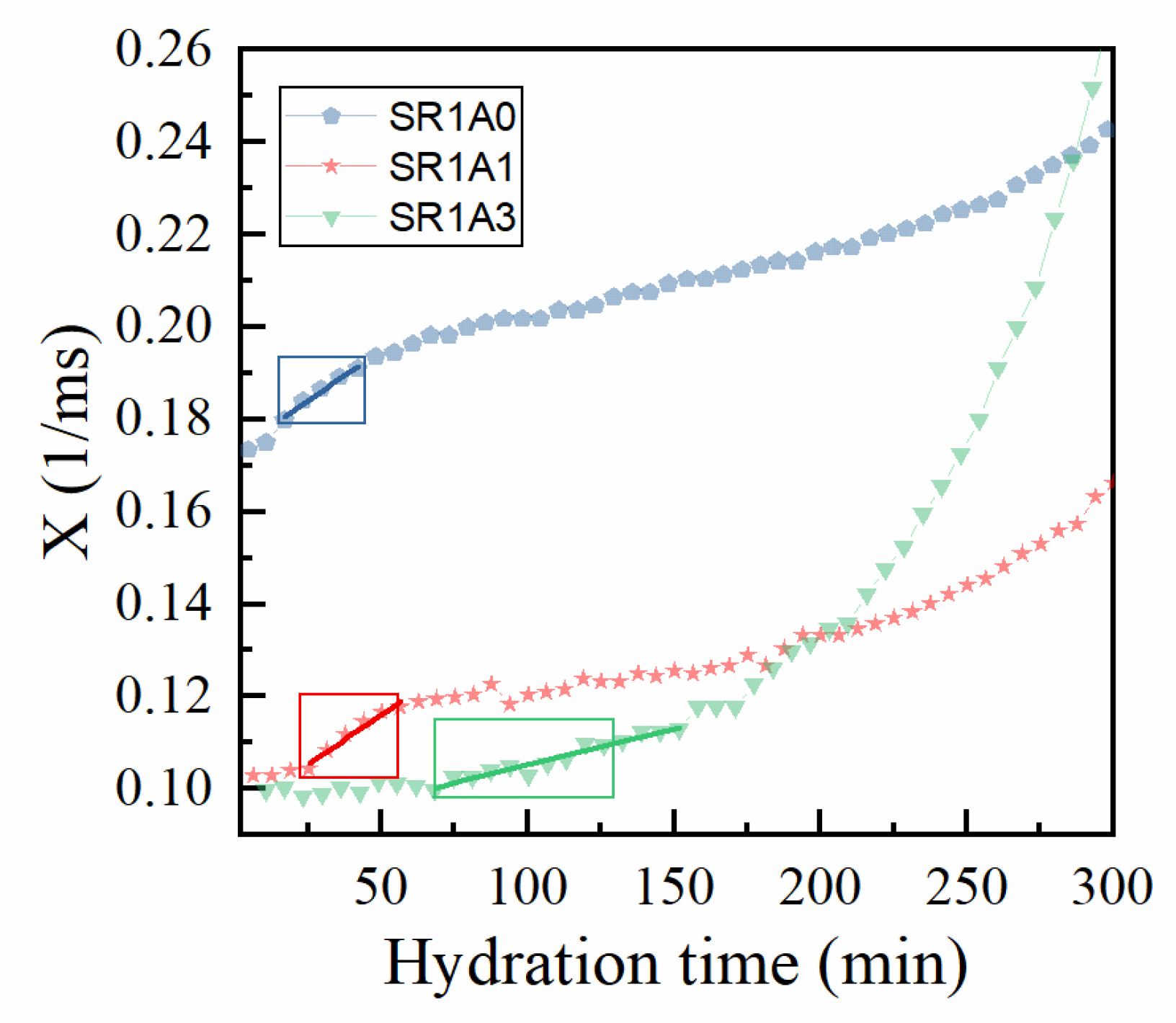
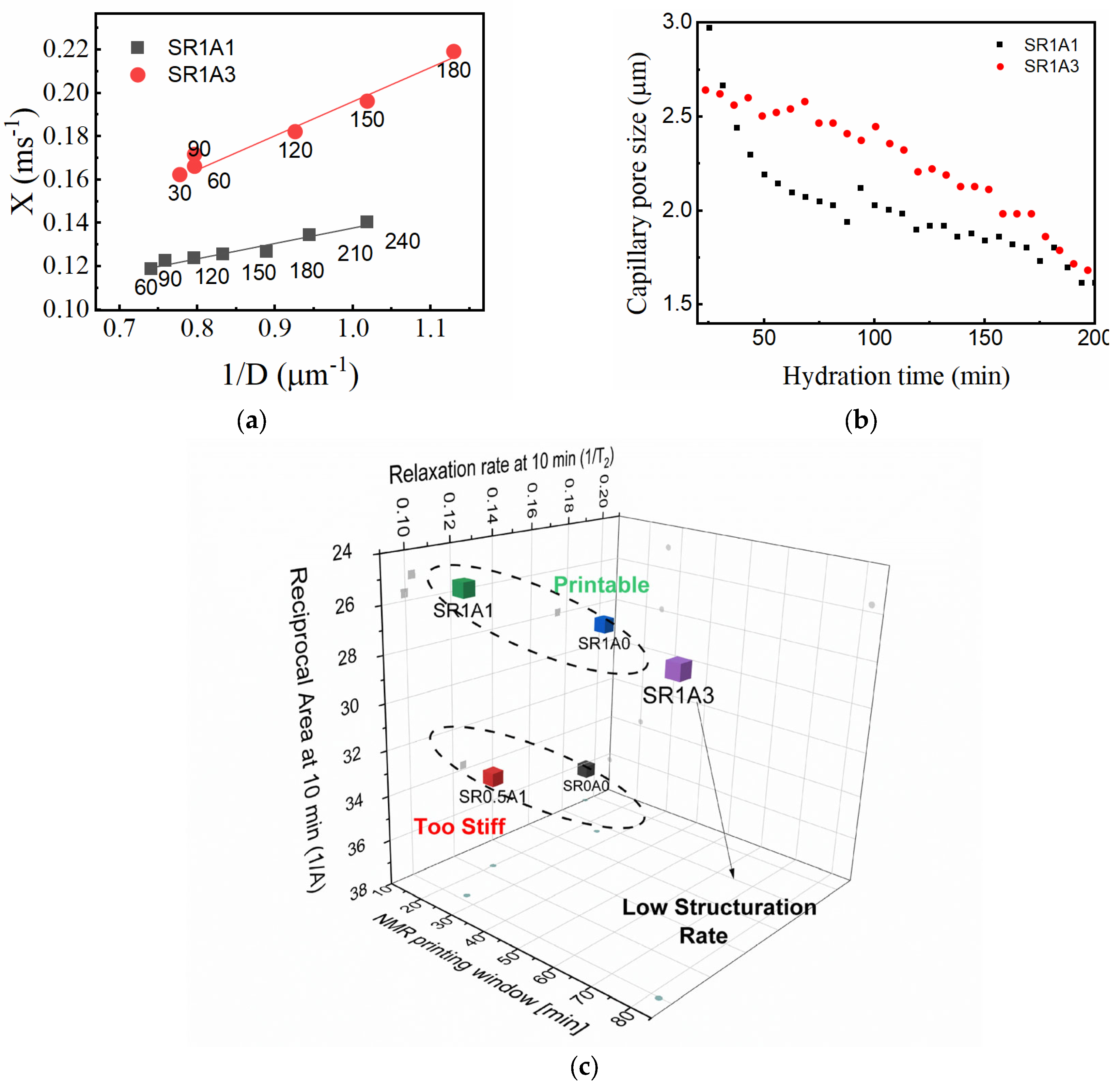
| Sample | w/b | a/b | SF (%) | SR (%) | CN (%) |
|---|---|---|---|---|---|
| M04 | 0.4 | 0.85 | 5 | 0 | 0 |
| SR0A0 | 0.3 | 0.75 | 0 | 0 | 0 |
| SR0.5A1 | 0.3 | 0.75 | −5 | 0.5 | 1 |
| SR1A0 | 0.3 | 0.75 | −5 | 1 | 0 |
| SR1A1 | 0.3 | 0.75 | −5 | 1 | 1 |
| SR1A3 | 0.3 | 0.75 | −5 | 1 | 3 |
| Sample | Tstart | Tstop | Printing Window (min) | Extrudability |
|---|---|---|---|---|
| M04 | 10 | - | n.a. | Failed |
| SR0A0 | 10 | 20 | <10 min | |
| SR0.5A1 | 5 | 20 | <10 min | |
| SR1A0 | 15 | 40 | 25 | Passed |
| SR1A1 | 35 | 75 | 40 | |
| SR1A3 | 60 | 120 | 60 |
| Sample | Tstart (min) | Tend (min) | X0 (1/ms) | ɣ (1/ms)/min | ɣ/ρ (µm∙min)−1 |
|---|---|---|---|---|---|
| SR1A0 | 20 | 40 | 0.173 | 4.3 × 10−4 | - |
| SR1A1 | 25 | 50 | 0.093 | 4.9 × 10−4 | 0.011 |
| SR1A3 | 70 | 150 | 0.089 | 1.6 × 10−4 | 0.002 |
Disclaimer/Publisher’s Note: The statements, opinions and data contained in all publications are solely those of the individual author(s) and contributor(s) and not of MDPI and/or the editor(s). MDPI and/or the editor(s) disclaim responsibility for any injury to people or property resulting from any ideas, methods, instructions or products referred to in the content. |
© 2025 by the authors. Licensee MDPI, Basel, Switzerland. This article is an open access article distributed under the terms and conditions of the Creative Commons Attribution (CC BY) license (https://creativecommons.org/licenses/by/4.0/).
Share and Cite
Rusu, M.M.; Ardelean, I. Relations Between the Printability Descriptors of Mortar and NMR Relaxometry Data. Materials 2025, 18, 3070. https://doi.org/10.3390/ma18133070
Rusu MM, Ardelean I. Relations Between the Printability Descriptors of Mortar and NMR Relaxometry Data. Materials. 2025; 18(13):3070. https://doi.org/10.3390/ma18133070
Chicago/Turabian StyleRusu, Mihai M., and Ioan Ardelean. 2025. "Relations Between the Printability Descriptors of Mortar and NMR Relaxometry Data" Materials 18, no. 13: 3070. https://doi.org/10.3390/ma18133070
APA StyleRusu, M. M., & Ardelean, I. (2025). Relations Between the Printability Descriptors of Mortar and NMR Relaxometry Data. Materials, 18(13), 3070. https://doi.org/10.3390/ma18133070






